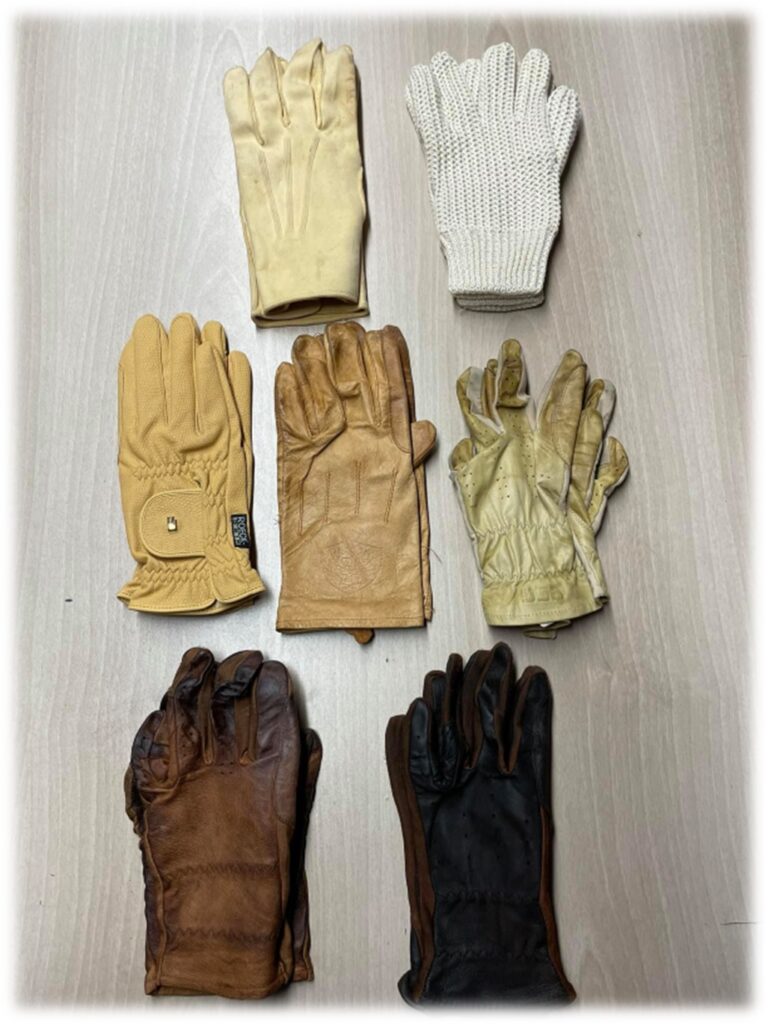
About Gloves
As many of you know, I LOVE educating people on the required appointments for the USEF ladies sidesaddle appointments classes. Today I am going to discuss gloves. Here is the exact wording from HU148:
“Gloves: Plain; heavy wash leather or brown leather gloves.
Rain Gloves: White or light colored rain gloves. Should be carried on off (right) side under billets and just showing in front of saddle flap. Fingers forward, thumbs in.”I’m not sure who assisted with the wording when the rules were rewritten a few years ago, but they weren’t as careful as they should have been. While the use of an offside saddle is rare- they are used, and the wording doesn’t take them into consideration. Anyway- like many others, I was taught your gloves should be brown. And I wore brown gloves in my early days. After learning more about the history and correctness of the attire over the years did I realize that the brown gloves you often see aren’t truly correct. But they aren’t wrong either . They are brown. The most correct and formal gloves are the chamois or wash leather gloves as pictured below.
To be truly accurate, the gloves should be chamois with buttons and no elastic or Velcro. But those are hard to find, and let me tell you from experience that even though they are lovely, they shed white fuzz all over your dark Melton wool apron. Don’t do it! It took me hours to clean my habit after I showed at one of the big shows with my actual vintage chamois gloves. I have found a few modern-makes that are VERY close in color and look the part without making a mess and are super simple to keep clean. I use the light leather chamois looking gloves when wearing formal attire, and wear the darker tans for my informal attire. I have pictured the darker chocolate brown color as a reference. The problem with these gloves is they look black from a distance and black is for mourning only so they wouldn’t have been worn and are not correct per the rules. But, these darker brown gloves are allowed per the rule book and are preferred by several of the ladies as your hands aren’t as noticeable when wearing darker gloves.
The other gloves you need to be aware of are your rain gloves. These are the knit string gloves typically worn in wet weather to help aid with grip on wet leather. They are referred to as rain gloves for this reason. On a near-sided sidesaddle they are carried on the offside under the billets to keep them safe and easily accessible by the rider. Many times in pictures from the offside you can see the fingers of the gloves peeking out from the offside flap of the saddle. These are either white or ecru (which is a yellowish tan color, or unbleached linen color). These gloves aren’t actually worn so size isn’t as critical. I like to carry the small size under my regular flap saddles and the XS or XXS on my show flap saddles. They seem to fit the best If anyone needs a pair of the rain gloves feel free to reach out to me. I do stock them since they are getting increasingly harder to find at a reasonable cost. As always please ask questions! Always happy to help.
Written by Amy Magee of Black Diamond Designs [email protected], a small custom leather and cloth sewing hobby shop that specializes in tack and attire for sidesaddle riders
More on Sidesaddle Gloves
This is to enhance what Amy Magee wrote about appointments and rain gloves. Since most of our modern riding stems from cowboys or foxhunting, we need to go back to the roots for our Corinthian or appointments class necessities. Rain gloves need to be bigger than your leather gloves. In case of rain, they were pulled on over your leather gloves. There is seldom time on a hunt to stop, take off your leather gloves, deposit them in a safe place, extricate your rain gloves, and pull them on. As for your sandwich case, please, please have a fresh sandwich, and no mayonnaise or lettuce. Sliced chicken, with butter on crustless bread, is appropriate. Judges have been known to take a bite, and you wouldn’t want to be responsible for Ptomaine poisoning.
By the way, many of you probably have never heard of a Corinthian class. This appointments class is designed for members of a hunt on an “agreeable mount to hounds” that has been hunted, and it requires a letter from the MFH stating the fact. Another requirement is that you must be able to crack your whip, and not have your horse shy. Some “hot doggers” have been known to crack their whip while going over a jump. Although I can’t think of a time when this might be necessary.
Bear in mind, that you will probably have more judges with a hunt background than a side-saddle background. So be prepared.
Written by Jo Rench
